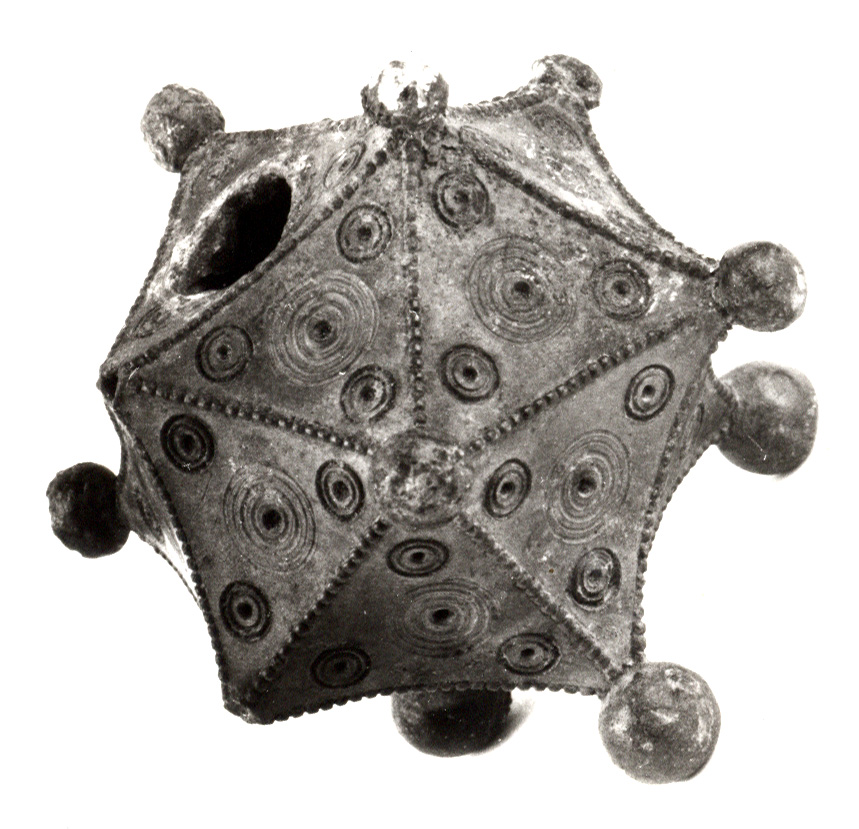Wooden skewers or pins through the holes.
One possible argument against casting the isocahedron in one piece - the clay that joins the core to the outer part of the mould would consist of a few quite thin cylinders that represent the positions of the pierced holes - these would be rather prone to failure in firing - potentially leaving the core rattling loose inside the mould (which would result in casting failure)
Further to this, textual descriptions say there are two of these, opposite each other.
From memory, I recall descriptions of these things (not sure if it was this example specifically) saying that some of the balls were cast in place and others had been soldered on - it was not clear if this was a repair of casting imperfections, or repair of parts that had broken off in use.
Bear in mind that what looks like a solder line may be a trace from the original wax form - if the wax balls were attached in place with melted wax
True, but I’m also talking about a material difference - if you look at the colour shot, the join area of the finials to the main body looks corroded differently.
This suddenly sounds a lot like a mace head.
I wonder if the dodecahedrons have two larger holes on opposite sides.
A ceremonial mace as a symbol of power would be something its owner might be buried with.
Not coming from any deep base of knowledge, but just knowing soldiers here. Is it possible that the items could be sold as scrap metal in the areas where they are not found?
After any military occupation, the scrap collectors come and scour the landscape. If bronze or other metals was worth more in those areas, then the sites would be well cleaned of them.
It is a virtual certainty that a number of dodecahedrons and other bronze artifacts were melted down for the metal when the items were found or stolen later on. With so few found so far it’s difficult to say how often that occurred.
… some of these are the size of a golf ball or smaller. And maces weren’t really a Roman Imperial thing, ceremonial or military.
The areas where they are not found include parts of the Empire that were the sources of those metals, like Iberia, as well as places that had been part of the Empire before there was an Empire. The correlation you’re looking for doesn’t seem to exist.
My guess is that the dodecahedra originally served some purpose, but over time, they stopped being used for that purpose, and started being used just as knickknacks. And then, some later craftsman who either didn’t know or didn’t care the original purpose crafted that icosohedron, in a style that was inspired by the dodecahedrons (but possibly not using the same techniques), strictly as a knickknack. In other words, whatever original purpose the dodecahedrons served, the icosahedron did not serve that same purpose. And I’m guessing that the large hole (or holes) on the icosahedron were there just to make it easier to make.
I also wouldn’t be surprised to learn that the same craftsman who made the icosahedron also made a similar cube, an octohedron, and a tetrahedron, so as to have a complete set of Platonic shapes. Those might not have survived, just because they were less interesting.
Has Cecil covered this one?
The big hole would do it, but if the core was filled with sand then it could be slurried out of even small openings, as it is done with cast iron.
Bumping this thread to mention that the mystery is still unsolved:
I am thinking of making one, I guess that lost-wax casting would be the way to try.
There are 3D printing resins that are designed to work like lost wax (you can do it with lost-PLA apparently, but there are other purpose-made filaments designed to burn away with no residue)
I have some small objects that were 3D printed in sintered stainless steel powder and then dipped in bronze to fill the gaps. They look like they are made of bronze. (They also look 3D printed, as you can see the texture.) That would be and awesome way to make them today.
Looking at the map in the linked article, I’m wondering if the “Roman” part is misleading. The highest density of sites seems to be just west of the Rhein river. But there’s nothing just east of it. That feels like an artifact of the collected data, rather than a real feature.
Every time I think about these things, I find that I favour a different hypothesis on what they were - why not a candle holder? It’s a really mundane, almost disappointing explanation, but:
- Dipped-wick wax or tallow candles are variable in diameter
- Examples have been found with traces of wax on them (no way that can be a remnant of casting - molten bronze would not leave any wax in the mould)
- The geographical distribution correlates fairly well with the cold/warm divide between where candles are more practical than liquid oil lamps, and vice versa
A “new” dodecahedron was found in Britain in June of 2023, which is intact and a bit larger than most of the others that have been found.

This might be the same one but it posted today:
